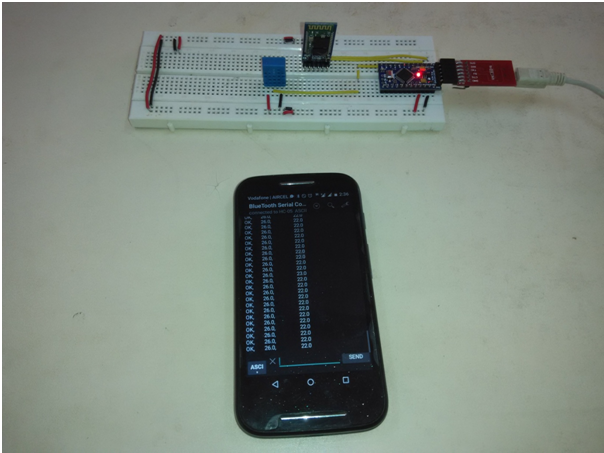Components Required –
Software Tools Required –
Block Diagram –
Circuit Connections –

Fig. 2: Prototype of Arduino Android and Bluetooth Module based Wireless Temperature and Humidity Monitor
The Arduino Pro Mini is the heart of the circuit and controls other modules in the circuit. The different modules are connected to the Arduino Pro Mini in the following manner –
How the circuit works –

Fig. 3: Image showing demonstration of Arduino Android and Bluetooth Module based Wireless Temperature and Humidity Monitor
When the circuit is powered on, the Arduino board loads the required libraries and start fetching data from the DHT-11 temperature and humidity sensor. DHT11 Temperature and Humidity Sensor is a digital sensor with inbuilt capacitive humidity sensor and Thermistor. It relays a real-time temperature and humidity reading every 2 seconds. The sensor operates on 3.5 to 5.5 V supply and can read temperature between 0° C and 50° C and relative humidity between 20% and 95%.
Programming Guide –
Project Source Code
###
#include <dht.h> dht DHT; #define DHT11_PIN 5 void setup() { Serial.begin(9600); Serial.println(" Engineers Garage "); Serial.println(" "); Serial.println(" Humidity and Temperature Wireless monitoring using Bluetooth "); Serial.println(" "); Serial.println("status,tHumidity (%),tTemperature (C)"); } void loop() { int chk = DHT.read11(DHT11_PIN); switch (chk) { case DHTLIB_OK: Serial.print("OK,t t t"); break; case DHTLIB_ERROR_CHECKSUM: Serial.print("Checksum error,t"); break; case DHTLIB_ERROR_TIMEOUT: Serial.print("Time out error,t"); break; case DHTLIB_ERROR_CONNECT: Serial.print("Connect error,t"); break; case DHTLIB_ERROR_ACK_L: Serial.print("Ack Low error,t"); break; case DHTLIB_ERROR_ACK_H: Serial.print("Ack High error,t"); break; default: Serial.print("Unknown error,t"); break; } Serial.print(DHT.humidity, 1); Serial.print(",t t t t t t"); Serial.println(DHT.temperature, 1); delay(2000); }###
Project Video
Filed Under: Electronic Projects
Filed Under: Electronic Projects


Questions related to this article?
👉Ask and discuss on EDAboard.com and Electro-Tech-Online.com forums.
Tell Us What You Think!!
You must be logged in to post a comment.